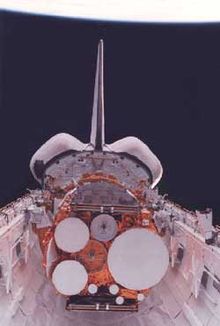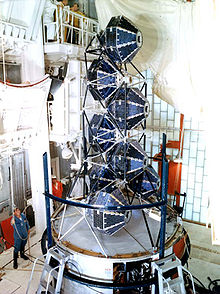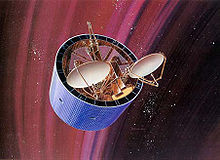Defense Satellite Communications System
The Defense Satellite Communications System ( DSCS ) is a satellite communications system used by the US armed forces for global communications between troop units. The DSCS program was coordinated by the Defense Communications Agency (DCA) and later the Defense Information Systems Agency (DISA).
From 1966 to 2003, 34 satellites of the first, 16 satellites of the second and 14 satellites of the third generation were launched.
The system Wideband Global SATCOM (WGS), originally planned as a temporary solution, will be launched as the successor system from 2007. Each of the WGS satellites has the same transmission capacity as the entire DSCS-III system.
IDSCP
The first generation of the system was put into orbit from 1966 under the name Initial Defense Communications Satellite Program ( IDCSP ).
Of Philco Ford satellite built each carrying an X-band - transponder with an omnidirectional antenna. Only IDSCP 19 carried an experimental antenna that was aimed at the earth. These were small satellites with a launch mass of only 45 kg, which were in an orbit with a period of 22.2 hours slightly below the geosynchronous orbit . In this orbit they drifted about 30 ° per day. This ensured that no place in the world would be without a satellite connection for a long time if one of the satellites failed.
The energy was supplied by solar cells that were located on the 26 surfaces of the polyhedral satellite body.
Up to eight satellites could be carried into near geostationary orbit with a Titan-3C , but the payload for most launches consisted of fewer IDCSP satellites and one or two experimental satellites. A total of 34 satellites were launched on five flights, 27 of which were successful. The takeoffs were from Cape Canaveral Air Force Station .
After the satellite constellation was taken into operational use, it was initially called the Interim Defense Satellite Communications System ( IDSCS ), later it was called DSCS I. During the Vietnam War , reconnaissance photos were transmitted using these satellites.
The concept of sub-synchronous orbit had not proven itself so well that it was adopted for the later generations of satellites, since the number of satellites required in the planned more complex systems would have massively increased costs.
| satellite | Start date | rocket | comment |
|---|---|---|---|
| IDCSP 1 - 7 | June 16, 1966 | Titanium-3C | Success (7 satellites); together with GHz-1 started |
| IDCSP (8) - (14) | August 26, 1966 | Titanium-3C | Bust (7 satellites); together with GHz-2 started |
| IDCSP 8 - 15 | January 18, 1967 | Titanium-3C | Success (8 satellites) |
| IDCSP 16-19 | July 1, 1967 | Titanium-3C | Success (4 satellites); together with DODGE and LES 5 launched |
| IDCSP 20-27 | June 13, 1968 | Titanium-3C | Success (8 satellites) |
DSCS II
The second generation of the DSCS system consisted of real geostationary satellites. These satellites, built by TRW , had a launch mass of 521 kg each and were significantly larger than those of the previous system. They had a spin-stabilized body and an antenna platform that were steadily aligned with the earth. Two 20-watt X-band transponders were used for data transmission. Solar cells with an output of 535 watts, which were mounted on the cylindrical satellite body, were used to supply the satellites with energy . To hedge eclipses the DSCS II satellites had three NiCd - accumulators . A hydrazine drive system allowed corrections to the orbital position.
The satellites were launched in pairs with Titan-3 (23) C rockets. The last two units each started with a satellite of the subsequent DSCS III generation on more powerful Titan 34D rockets.
The operational constellation consisted of four satellites, which were stationed at the orbit positions 60 ° E, 175 ° E, 12 ° W and 135 ° W, as well as two replacement satellites, which were maneuvered to the respective positions if necessary.
| satellite | Start date | rocket | comment |
|---|---|---|---|
| DSCS II 1 (DSCS II A1) | 3rd November 1971 | Titan-3 (23) C | success |
| DSCS II 2 (DSCS II A2) | |||
| DSCS II 3 (DSCS II B3) | December 13, 1973 | Titan-3 (23) C | success |
| DSCS II 4 (DSCS II B4) | |||
| DSCS II 5 (DSCS II B5) | May 20, 1975 | Titan-3 (23) C | Failure to reach low orbit |
| DSCS II 6 (DSCS II B6) | |||
| DSCS II 7 (DSCS II C7) | May 12, 1977 | Titan-3 (23) C | success |
| DSCS II 8 (DSCS II C8) | |||
| DSCS II 9 (DSCS II C9) | March 25, 1978 | Titan-3 (23) C | Failure |
| DSCS II 10 (DSCS II C10) | |||
| DSCS II 11 (DSCS II C11) | December 14, 1978 | Titan-3 (23) C | success |
| DSCS II 12 (DSCS II C12) | |||
| DSCS II 13 (DSCS II D13) | November 21, 1979 | Titan-3 (23) C | success |
| DSCS II 14 (DSCS II D14) | |||
| DSCS II 15 (DSCS II F16) | October 30, 1982 | Titan-34D IUS | Success; started with DSCS III 1 |
| DSCS II 16 (DSCS II E15) | 4th September 1989 | Titan-34D Transtage | Success; started with DSCS III 4 |
DSCS III

The third generation satellites were manufactured by General Electric (later Martin Marietta and Lockheed Martin ). These were 1,235 kg heavy, triaxial stabilized satellites. The energy supply was ensured by two solar cell booms with an output of 1240 watts, which were protected by NiCd batteries. The planned lifespan of the third generation satellites was ten years, but most satellites exceeded this.
The communication systems of the DSCS III satellites consisted of six SHF transponders. Two global horn antennas and a 61-beam nulling antenna were used as receiving antennas. The transmitting antennas consisted of two horn antennas, two configurable 19-beam antennas and a swiveling parabolic antenna .
As part of the Service Life Enhancement Program (SLEP), the last four satellites were modified so that their data transmission rate was increased by 200%.
First, like their predecessors, the DSCS III satellites were launched in pairs, using both titanium rockets and the space shuttle . Upper stages were used in each case, which could transport the satellites directly into their geostationary orbit. When the space shuttle was no longer available for satellite transport after the Challenger catastrophe , the remaining satellites were transferred to Atlas II and later Delta IV rockets. Since these carrier systems were not able to carry out a direct injection into the geostationary orbit, the DSCS III satellites were given an additional upper stage with the IABS stage, which carried out this task.
| satellite | Start date | rocket | comment |
|---|---|---|---|
| DSCS III 1 (DSCS III A1) | October 30, 1982 | Titan-34D with IUS | Success; started with DSCS II 15 |
| DSCS III 2 (DSCS III B4) | 3rd October 1985 |
Space Shuttle with IUS ( STS-51-J ) |
success |
| DSCS III 3 (DSCS III B5) | |||
| DSCS III 4 (DSCS III A2) | 4th September 1989 | Titan-34D Transtage | Success; started with DSCS II 16 |
| DSCS III 5 (DSCS III B14) | February 11, 1992 | Atlas-2 with IABS | success |
| DSCS III 6 (DSCS III B12) | 2nd July 1992 | Atlas-2 with IABS | success |
| DSCS III 7 (DSCS III B9) | July 19, 1993 | Atlas-2 with IABS | success |
| DSCS III 8 (DSCS III B10) | November 28, 1993 | Atlas-2 with IABS | success |
| DSCS III 9 (DSCS III B7) | July 31, 1995 | Atlas-2A with IABS | success |
| DSCS III 10 (DSCS III B13) | October 25, 1997 | Atlas-2A with IABS | success |
| DSCS III 11 (DSCS III B8) | January 21, 2000 | Atlas-2A with IABS | success |
| DSCS III 12 (DSCS III B11) | October 20, 2000 | Atlas-2A with IABS | success |
| DSCS III 13 (DSCS III A3) | March 11, 2003 | Delta IVM with IABS | success |
| DSCS III 14 (DSCS III B6) | August 29, 2003 | Delta IVM with IABS | success |
Web links
- Federation of American Scientists - DSCS 3 ( Memento from August 1, 2012 in the web archive archive.today ) (English)
- NASA JPL - DSCS ( Memento from November 10, 2017 in the Internet Archive ) (English)
- Air Force - DSCS III (English)
- Gunter's Space Page: IABS (English)
Individual evidence
- ^ Pre-launch ops keep crews busy at the Cape . Spaceflight Now. Retrieved December 19, 2010.
- ↑ a b Directory of US Military Rockets and Missiles: TRW ES-4 DSCS II
- ↑ Federation of American Scientists - DSCS 3 ( Memento from August 1, 2012 in the web archive archive.today )
- ↑ Directory of US Military Rockets and Missiles: General Electric ES-5 DSCS III





